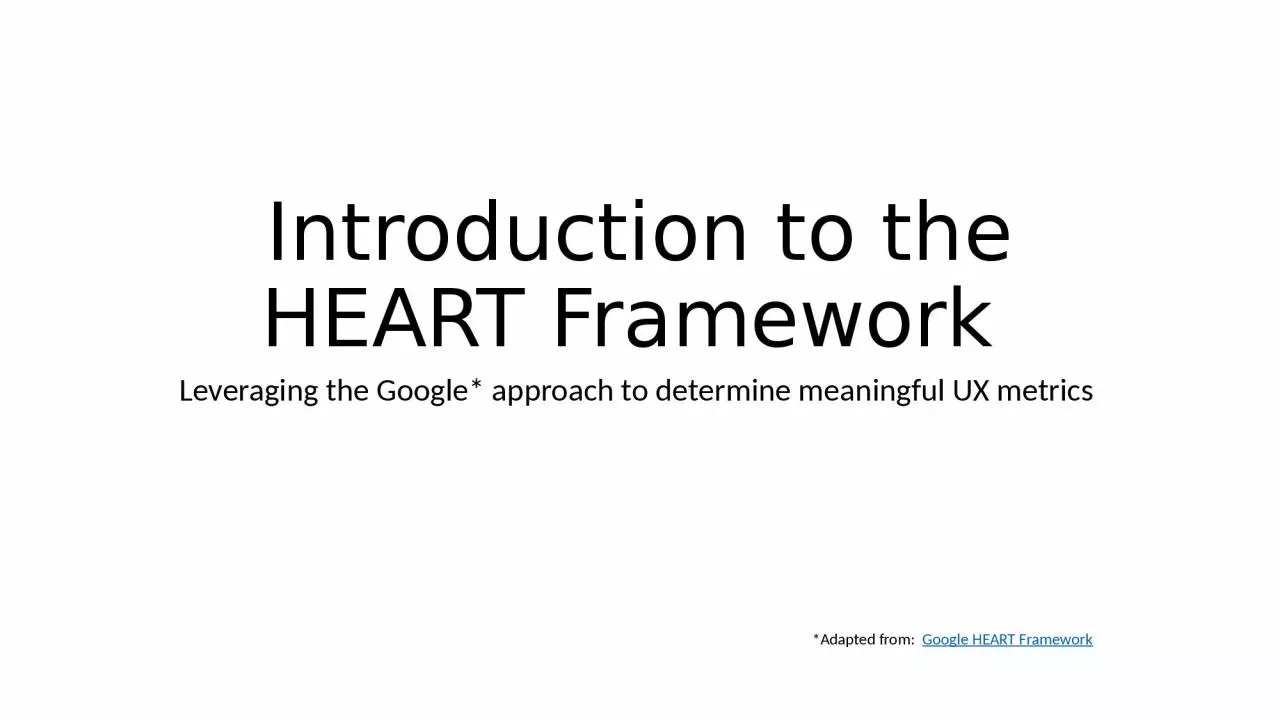

Leveraging the Google approach to determine meaningful UX metrics Adapted from Google HEART Framework The HEART framework provides a method for defining user experience measures for a system product or feature ID: 933960
Download Presentation The PPT/PDF document "Introduction to the HEART Framework" is the property of its rightful owner. Permission is granted to download and print the materials on this web site for personal, non-commercial use only, and to display it on your personal computer provided you do not modify the materials and that you retain all copyright notices contained in the materials. By downloading content from our website, you accept the terms of this agreement.
Slide1
Introduction to the HEART Framework
Leveraging the Google* approach to determine meaningful UX metrics
*Adapted from:
Google HEART Framework
Slide2The HEART framework provides a method for defining user experience measures for a system, product, or feature.
The following slides describe:Dimensions represented in the HEART framework
Steps to apply the frameworkHEART framework examples
Helpful tips for applying framework
Introduction to the HEART Framework
Slide3HEART
Framework for M
easuring UX
H
AR
T
E
Happiness
Focuses on subjective aspects of a product or feature, like satisfaction, design appeal, and perceived usability.
Engagement
Focuses on the frequency, intensity, and overall level of involvement with a product or feature(s).
Adoption & Retention
Focuses on the
initial uptake
and
continued
use of a product or feature(s) over time.
Task SuccessFocuses on how efficiently, effectively, and successfully users accomplish key tasks using the product or feature(s).
How do you know users are satisfied?
How deeply are users connected to the product or feature?
How quickly is the new product or feature used initially?How is usage sustained over time?
How effectively do users complete key activities?
Based on:
Google HEART Framework
Slide4Identify Goals
Pick the HEART dimension(s) that are most relevant to the project
Determine which project goals rely strongly on the user experience
Map goals to the selected HEART dimension(s)
Determine Signals
For each
mapped goal,
identify
behavioral and/or attitudinal indicators of success (or failure) Identify MetricsDetermine possible ways to measure the signals
(i.e. the behaviors and attitudes) over timePrioritize and Select MetricsReview and prioritize metrics based on value and difficulty/feasibility.
Based on prioritization, select metrics to be used.
The HEART Framework Process
1
2
3
4
Slide5This example shows how HEART could be used to identify a set of UX metrics for a new mobile app that enables "on the go" invoice approval for users in a large organization
HEART Example
(1
of 3)
HEART Dimension
Goals
Signals
Metrics
H
appiness
App serves as a trusted easy-to-use tool for invoice approval on the go
User perception
User satisfaction scores over time
Comparison of baseline and post implementation System Usability Scale (SUS) scores
App is perceived as valuable by all users despite varying number of invoices to approve
User perception
User satisfaction score trends over time for users with a large number of invoices compared with users with a small number of invoices
Slide6HEART Example
(2 of 3)
HEART Dimension
Goals
Signals
Metrics
A
doption and
R
etention
App is utilized as an alternative to the laptop
App downloads
Unique app installs over time
Continued app use
App deletion rates over time
App usage tracking over time
App usage
App launch frequency per day, week, month, etc. as compared to baseline of mobile app and laptop
Approvals performed on laptop vs app
Ratio of total invoices dispositioned on app vs. laptop over time
Users recommend app to colleagues
Net Promoter Score (NPS) for app
Relative change in NPS over time
Slide7HEART Example (3 of 3)
HEART Dimension
Goals
Signals
Metrics
T
ask Success
Users can effectively disposition invoices on app
Complete disposition of individual invoices on app
Ratio of invoices dispositioned by user on the app v. laptop over time
Time taken to disposition an invoice once it arrives in inbox
Invoice disposition error rates
Error rate comparison of laptop v. mobile app
Slide8This is a team activity – get the right people involved
The HEART Framework is a structured “thinking tool”. Specific signals and metrics need to be identified by the team A “signal” is an indicator of what success or failure might look like in terms of user behaviors and/or attitudes
“Metrics” are the specific ways to measure the signal over timeWhen prioritizing and selecting metrics, aim for a final set of metrics that includes all the relevant dimensions of the HEART framework
Less is more. It’s better to aim for a fewer (more meaningful) metrics, based on the goals.
A Few Tips